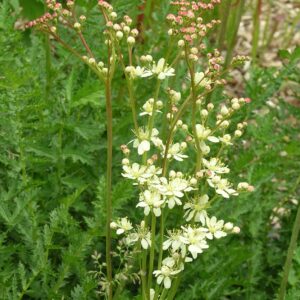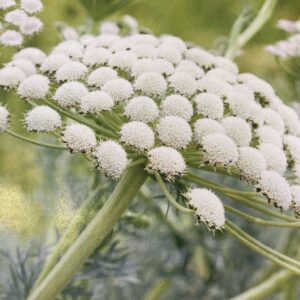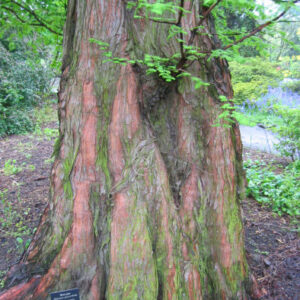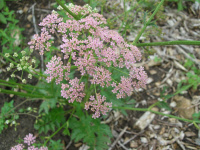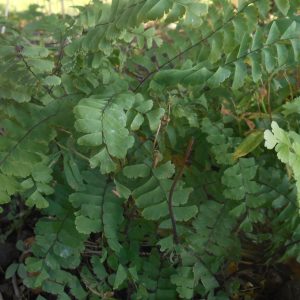…Chaerophyllum hirsutum ‘Roseum’ Hairy chervil, Cow parsley Z 5-7 I love this for its airy, rose-pink umbels and fern-like apple-scented, fragrant foliage. It flowers in spring to early summer. Delicate-looking,…
More »Search Results for: Lady fern
-
Filipendula vulgaris syn. F. hexapetala Dropwort or Meadowsweet Z 3-9
OUT OF STOCK In early summer bundles of milk white ball-shaped buds and open blossoms atop clumps of finely-cut, fern-like leaves, both flowers and foliage fragrant, early to mid-summer....
OUT OF STOCK
In early summer bundles of milk white ball-shaped buds and open blossoms atop clumps of finely-cut, fern-like leaves, both flowers and foliage fragrant, early to mid-summer.
Size: 24" x 18"
Care: sun in moist to moist well-drained soil
Native: Europe, north and central Asia
Wildlife Value: attracts bees, beetles and fliesFilipendula is Latin from filum meaning thread and pendulus meaning hanging for small tubers hanging by threadlike roots. In the 1600’s Nicholas Culpepper described Meadowsweet’s medicinal uses as curing bladder problems, throat, lung diseases and “the falling sickness.” Filipendula vulgaris also remedied bloated stomachs “dissolving and breaking the wind.”
-
Seseli gummiferum Moon carrot Z 5-9 self-seeding biennial or short-lived perennial.
Five-inch diameter mound of many circles of pale pink to white flowers atop silvery, frilly, fern-like foliage flowering in mid-summer into early fall.
Five-inch diameter mound of many circles of pale pink to white flowers atop silvery, frilly, fern-like foliage flowering in mid-summer into early fall.
Size: 2-3’ x 12-18”
Care: Sun to part-shade in well-drained to moist well-drained soil
Native: Crimea, Turkey and South Aegean
Wildlife Value: Deer resistant. Butterfly magnet; host for caterpillar of Eastern swallowtail butterfly.Seseli is an ancient Greek name of an umbelliferous plant. This species first described by Linnaeus in 1735. In Re classified and renamed in 1830 in Prodromus systematis naturalis regni vegetabilis, sive, Enumeratio contracta ordinum generum specierumque plantarum huc usque cognitarium, juxta methodi naturalis, normas digesta.
-
Adlumia fungosa Allegheny vine, Climbing fumitory, Bleeding heart vine Biennial Z 4-8
OUT OF STOCK Dangling pink to white Bleeding heart-like flowers bloom all summer, June-September. Fern-like foliage on twining stems...
OUT OF STOCK
Dangling pink to white Bleeding heart-like flowers bloom all summer, June-September. Fern-like foliage on twining stems
Size: 6-10’ x 12”
Care: part shade to shade in moist to moist well-drained, acidic soil
Native: Nova Scotia to No. Carolina west to Minnesota Wisconsin native status-special concern
Wildlife Value: attracts bumblebees1st described in 1789 (Aiton, Vol. 3 Hortus Kewensis).
-
Metasequoia glyptostroboides Dawn redwood Z 4-8
Fast-growing, pyramidal-shaped deciduous conifer. The orange to brown trunk base tapers and thickens with up to a dozen large buttress-like root flares extending several feet up the trunk. Feathery, fern-like,...
Fast-growing, pyramidal-shaped deciduous conifer. The orange to brown trunk base tapers and thickens with up to a dozen large buttress-like root flares extending several feet up the trunk. Feathery, fern-like, soft foliage emerges light green in spring, and turns red-bronze in fall before dropping. Its branches are well-attached and make excellent climbing.
Size: 70-90’ x 15-25’
Care: sun in moist to moist well-drained, slightly acid soil
Native: Szechuan China
Awards: Royal Botanic Garden Award of Garden Merit, Yew Dell Botanical Gardens’ Theodore Klein Plant Awards & Pennsylvania Horticultural Society GoldFrom fossil records, dawn redwood is known to have existed as many as 50,000,000 years ago. However, it was not until 1941 that dawn redwood was first discovered growing in the wild near the town of Modaoqi China by Chinese forester, T. Kan. Seeds collected from the original site were made available to the Missouri Botanical Garden in 1947. Seedlings grown therefrom were planted in front of the Lehmann Building at MBG in 1952 where they have now developed into large mature trees (70’+ tall). Dawn redwood is a deciduous, coniferous tree that grows in a conical shape to 100’ tall. It is related to and closely resembles bald cypress (Taxodium) and redwood (Sequoia).
-
Chaerophyllum hirsutum ‘Roseum’ Hairy chervil Z 5-7
...is an archive page preserved for informational use. Airy rose-pink umbels like a short, pink Queen Anne’s lace, blooming in spring to early summer, compliment the fern-like apple-scented fragrant foliage....
ARCHIVED
Note: This is a plant not currently for sale. This is an archive page preserved for informational use.
Airy rose-pink umbels like a short, pink Queen Anne’s lace, blooming in spring to early summer, compliment the fern-like apple-scented fragrant foliage.
Size: 24” x 12”
Care: sun to part shade in moist well-drained soil, cut back to refresh foliage and rebloom.
Native: Spain to Greece
Awards: Elisabeth Carey Miller Botanical Garden Great Plant PickNamed from Greek chairo meaning “to please” & phyllon meaning“leaf.” The species collected before 1770.
-
Adiantum pedatum Maidenhair fern Z 4-9
Grown for its delicate-appearing leaflets arranged in rows. One of internationally known garden designer Piet Oudolf’s 100 “MUST HAVE” plants, Gardens Illustrated 94 (2013)...
Grown for its delicate-appearing leaflets arranged in rows. One of internationally known garden designer Piet Oudolf’s 100 “MUST HAVE” plants, Gardens Illustrated 94 (2013)
Size: 12-24”x 12”
Care: Shade in moist soil
Native: all parts of No. America including Wisconsin
Awards: England’s Royal Horticultural Society Award of Merit.Cherokee made a tea from this for flu, fever, and rheumatism, paralysis and asthma. Native Americans used stem to make a hair wash and applied a topical poultice of masticated fronds to wounds to stop bleeding. 1st described by French botanist Cornut in 1635. Introduced to gardens in 1635 from Canada where it grew in “such quantities that the French sent it from thence in package for other goods and the apothecaries at Paris use it for (another Maidenhair) in all their compositions in which that is ordered.” Philip Miller (1768). Tradescant the Younger introduced it to English gardens in 1638 when he sent it from Virginia Colony to London. English herbalist Nicholas Culpepper claimed it as “a good remedy for coughs, asthmas, pleurisy, etc., and on account of being a gentle diuretic, also in jaundice, gravel and other impurities of the kidneys.” Father of mixed perennial gardens, William Robinson, called this “elegant…unquestionably one of the most distinct and beautiful of the hardy ferns.” The Garden 1876.
About Us
…“For sale by Owner,” ninety-three year old widow Anne Patterson was moving 2000 miles to live with her daughter. She beamed as she showed me the Fern-leaved bleeding hearts under…
More »-
Polystichum tsus-simense Korean Rock Fern Z 5-9
Compact, glossy green fronds with black stems growing in a rosette....
Compact, glossy green fronds with black stems growing in a rosette.
Size: 12-20” x 12-16”
Care: Shade to part shade in moist well-drained soil
Native: Korea
Awards: Royal Horticulture Society Award of Garden Merit. Great Plant Pick Elizabeth Carey Miller Botanic Garden1st collected “on the “Island of Tsus Sima, in the Straits of Corea” by Charles Wilford in 1859. Species Filicum, Vol. 4, p. 16 (1862) William J. Hooker, In 1854 Charles Wilford started as an assistant in the herbarium at the Royal Botanic Gardens, Kew. Sent to Asia in 1857 he collected plants in Hong Kong, moving to Taiwan the following year and to Korea and Japan in 1859.
-
Adiantum aleuticum Western Maidenhair Fern Z 3-9
OUT OF STOCK Bright green fronds perch atop black stems like the fingers of an open hand...
OUT OF STOCK
Bright green fronds perch atop black stems like the fingers of an open hand
Size: 30” x 30”
Care: shade in moist, well-drained soil
Native: East and west of the Cascade Mountains and is also found scattered along the eastern seaboard
Wildlife Value: Deer resistant
Awards: Elisabeth C Miller Great Plant Pick, Royal Horticultural Society Award of Garden MeritAccording to folklore if a girl can hold the stem without causing the leaves to tremble, then she was chaste.
Natives used the stems in basketry designs and made tea from the leaves to use as a hair wash. Quinault burnt the leaves and rubbed ashes in their hair to make it long, shiny and black. California Natives used the stems for pierced earrings, inserting them into the ear lobe to keep the hole from closing. They chewed the leaves to remedy internal wounds, chest pain, or stomach trouble and made a cough syrup from it.

